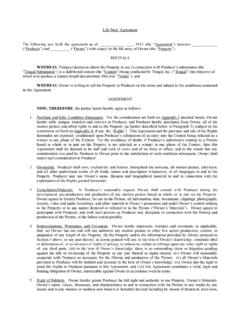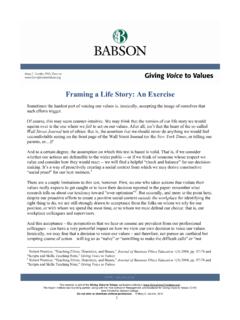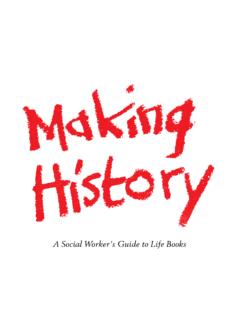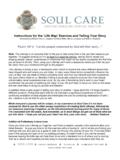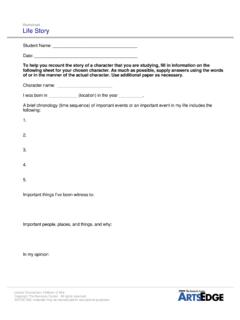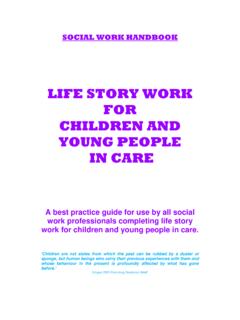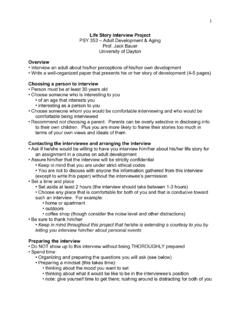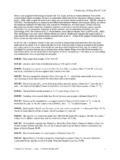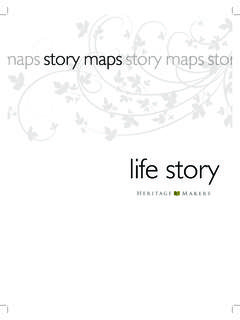Transcription of Continuity and Change in the Life Story: A Longitudinal ...
1 Continuity and Change in the life story : ALongitudinal Study of Autobiographical Memories inEmerging AdulthoodDan P. McAdams,1 Jack J. Bauer,2 April R. Sakaeda,1 Nana Akua Anyidoho,1 Mary Anne Machado,1 KatieMagrino-Failla,1 Katie W. White,1and Jennifer L. Pals11 Northwestern University2 Northern Arizona UniversityABSTRACTIf a person s internalized and evolving life story (narrativeidentity) is to be considered an integral feature of personality itself, thenaspects of that story should manifest some Continuity over time while alsoproviding evidence regarding important personality Change . Accordingly,college freshmen and seniors provided detailed written accounts of 10 keyscenes in their life stories, and they repeated the same procedure 3 monthsand then 3 years later.
2 The accounts were content analyzed for reliablenarrative indices employed in previous studies of life stories: emotionaltone, motivational themes (agency, communion, personal growth), andnarrative complexity. The results showed substantial Continuity over timefor narrative complexity and positive (vs. negative) emotional tone andmoderate but still significant Continuity for themes of agency and addition, emerging adults (1) constructed more emotionally positivestories and showed (2) greater levels of emotional nuance and self-differ-entiation and (3) greater understanding of their own personal develop-ment in the 4th year of the study compared to the 1st year. The study isthe first to demonstrate both temporal Continuity and developmentalThe authors would like to thank Michelle Green, Emily Kissel, Gina Logan, RuthMcAdams, and Allen Swanson for their assistance in data collection, coding, andanalysis.
3 The authors would also like to thank Jonathan Adler, Emily Durbin,and three anonymous reviewers for their comments on an earlier version of thismanuscript. The research described herein was supported by a grant to the firstauthor to establish the Foley Center for the Study of Lives at Northwestern correspondence to: Dan P. McAdams, Foley Center for the Study of Lives,Northwestern University, 2120 Campus Drive, Evanston, IL 60208. E-mail: of Personality74:5, October 2006r2006, Copyright the AuthorsJournal compilationr2006, Blackwell Publishing, : in narrative identity over time in a broad sampling of personallymeaningful life - story approaches to personality suggest that people createmeaning and purpose in their lives through the construction oflife stories (Hermans, 1996; McAdams, 1985, 1999; Singer, 2004;Thorne, 2000; Tomkins, 1987).
4 People explain who they are, howthey came to be, and where they believe their lives may be going byformulating, telling, and revising stories about the personal past andthe imagined future (Bruner, 1990). A person s life story is an inter-nalized and evolving narrative of the self that selectively reconstructsthe past and anticipates the future in such a way as to provide a lifewith an overall sense of coherence and purpose. Like dispositionaltraits, it has been argued, individual differences in the structure andcontent of life stories represent significant and measurable aspects ofpersonality itself (Hooker & McAdams, 2003; McAdams, 1995). Inthat traits sketch out broad consistencies in behavior and experience,trait assessments ultimately yield adispositional profileof psycho-logical individuality ( , Costa & McCrae, 1994).
5 By contrast, lifestories speak to how a person integrates his or her life in time andsocial context and what he or she believes that life means, ultimatelyexpressing the person snarrative identity(Singer, 2004). A full ac-counting of personality should encompass, among other things, bothdispositional profiles and narrative , however, narrative identity is to be considered an integral fea-ture of personality itself, then the themes, images, and plots thatmake it up should show some evidence of Continuity over time. Yetvirtually no studies have examined the extent to which individualdifferences in the structure and content of life stories show longitu-dinal consistency. Nor have quantitative, empirical studies carefullyexamined developmental Change .
6 Narrative psychologists typicallyargue that life stories are strongly shaped by environmental and cul-tural forces, leading to the expectation that narrative identitiesshould be rather less stable than dispositional traits over time(McAdams, 1994), more subject to situational fluctuation and ne-gotiation (Shotter & Gergen, 1989), and likely to reveal develop-mental Change (Young, Stewart, & Miner-Rubino, 2001). At thesame time, narrative identity would be expected to showsomethematic Continuity from one point in time to the next if it reflectscharacteristic ways in which people make meaning of their lives1372 McAdams, Bauer, Sakaeda, et al.(McAdams, 1985; Singer, 1995). The current study employs a lon-gitudinal design to address the extent to which individual differencesin certain basic features of life stories show Continuity over time andthe extent to which they express developmental Continuity and Developmental ChangePersonality research on life stories has tended to focus on the iden-tification and measurement of key autobiographical scenes, or whatSinger and Salovey (1993) first termedself-defining memories(Blagov& Singer, 2004; McLean & Thorne, 2003).
7 A common researchstrategy is to collect narrative accounts of important scenes in the lifestory, code them for psychologically significant themes and images,and then relate the resultant scores to other measures of personality,development, or well-being. For example, studies have documentedsignificant relationships between life -narrative themes and self-report traits (McAdams et al., 2004), TAT-based motives(McAdams, Hoffman, Mansfield, & Day, 1996; Woike, 1995), anddevelopmental stages and concerns (Bauer & McAdams, 2004a;Bluck & Gluck, 2004; Conway & Holmes, 2004; King, Scollon,Ramsey, & Williams, 2000; McAdams, Diamond, de St. Aubin, &Mansfield, 1997; Pals, 1999). Research also shows that themes ofpersonal redemption (McAdams, Reynolds, Lewis, Patten, & Bow-man, 2001) and self-determination and growth (Bauer & McAdams,2004b; Bauer, McAdams, & Sakaeda, 2005; King & Raspin, 2004;King & Smith, 2004) in key life - story scenes predict psychologicalwell-being and successful coping with stress.
8 Personality psycho-logists have also explored how accounts of life - story scenes areshaped by interpersonal relationships (Pasupathi, 2001; Thorne,McLean, & Lawrence, 2004) and by gender, class, and culture(McAdams, 2006; Wang & Conway, 2004; Young et al., 2001).Although personality psychologists have developed a number ofcoding schemes for analyzing individual differences in the contentand structure of life - story scenes, they have paid little attention tothe issue of temporal stability versus Change in these individualdifferences. The one exception is Thorne, Cutting, and Skaw (1998),who collected young adults accounts of important memories aboutinterpersonal relationships at two points in time, separated by 6months.
9 They found that only 12% of the relationship memories toldLife Stories1373at the second session could be identified as the exact same eventsdescribed by the same participants the first time around. The re-searchers found little evidence for Longitudinal stability, moreover,with respect to the main characters ( , parents, siblings, friends)portrayed in the events. When the memories were coded for emo-tional and motivational themes, however, some evidence for stabilitywas obtained. Among the 46 participants tested, modest but signif-icant correlations were found between the percentage of memoriesidentified at Time 1 and at Time 2 showing positive outcomes( ), negative outcomes ( ), the desire to assert or control( ), and the desire to avoid ( ).
10 Should one expect to find Longitudinal Continuity in life -narrativeaccounts? Narrative researchers who adopt postmodern approachesin the social sciences tend to argue that life - story accounts are mo-mentary performances expressing the exigencies of the interpersonalsituation in which they are told ( , Shotter & Gergen, 1989;Wortham, 2001). From this perspective, life narratives are viewedas forms of discourse that are more likely to reveal language gamesand cultural norms than inherent tendencies in persons. Althoughthey do not downplay the performative and discursive functions oflife- story telling, other narrative psychologists maintain that people saccounts of significant life - story scenes may nonetheless express corethemes (Wiseman & Barber, 2004) and underlying dynamics (Singer,1995) of personality.
